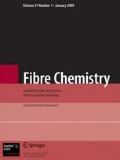Abstract
Solid nanosize Aerosil additives almost do not alter the properties of melts of PP/CPA blends. Melts of three-component blends are strengthened in a longitudinal velocity gradient field, manifested by a sharp increase in the maximum possible spinneret drawing. Nanosize Aerosil additives do not prevent realization of specific fibre formation in flow of melts of PP/CPA blends. As a result of stabilization of the liquid jets of PP in a CPA matrix, thinner (up to 0.30–0.15 µm) microfibres are formed with low dispersion of the distribution by diameters. This increases the specific surface area by 3–4 times. Nanofilled PP microfibres and new filter materials that combine high output and efficiency (99.999% with respect to 0.3 µm particles) were made for the first time. Aerosil additives act as crystallization centers during spinning of PP microfibres, which prevents the liquid jets from breaking down into drops. Incorporation of highly disperse Aerosils can be a method of regulating crosslinking of the polymer in the disperse phase in the matrix polymer.
Similar content being viewed by others
References
Mihail C. Rocco, R. S. Williams, and P. Alivisatos (eds.), Nanotechnology Research Directions, Kluwer Academic, Dordrecht, Netherlands (2000).
M. V. Tsebrenko, N. M. Rezanova, and I. A. Tsebrenko, Khim. Volokna, No. 4, 25–31 (2002).
V. G. Rezanova and M. V. Tsebrenko, Khim. Volokna, No. 2, 21–26 (2003).
G. I. Taylor, Proc. Roy. Soc. London, A, 146, 501–526 (1934).
S. P. Gubin, Ros. Khim. Zh., 44, No. 6, 23–31 (2000).
L. A. Utracki, Z. Bakerdijiane, and M. R. Kamal, J. Appl. Polym. Sci., 19, No. 19, 481–501 (1975).
R. V. Lutsik, E. S. Malkin, and I. I. Abarzhi, Heat and Mass Exchange in Processing Textile Materials [in Russian] Naukova, Dumka, Kiev (1993).
G. S. Katz and J. V. Milevsky (eds.), Handbook for Fillers in Reinforcement of Plastics, Van Nostrand Reinhold, Los Alamos, New Mexico (1978).
M. V. Tsebrenko, N. M. Rezanova, et al., Funkts. Mater., 2, No. 3, 362 (1995).
M. V. Tsebrenko, G. V. Vinogradov, et al., Kolloidn. Zh., 38, No. 1, 200–203 (1976).
Author information
Authors and Affiliations
Additional information
__________
Translated from Khimicheskie Volokna, No. 5, pp. 16–21, September–October, 2007.
Rights and permissions
About this article
Cite this article
Tsebrenko, M.V., Rezanova, N.M., Kuvaeva, E.P. et al. Production of polypropylene microfibres containing a filler in the nanostate. Fibre Chem 39, 372–378 (2007). https://doi.org/10.1007/s10692-007-0080-1
Issue Date:
DOI: https://doi.org/10.1007/s10692-007-0080-1




